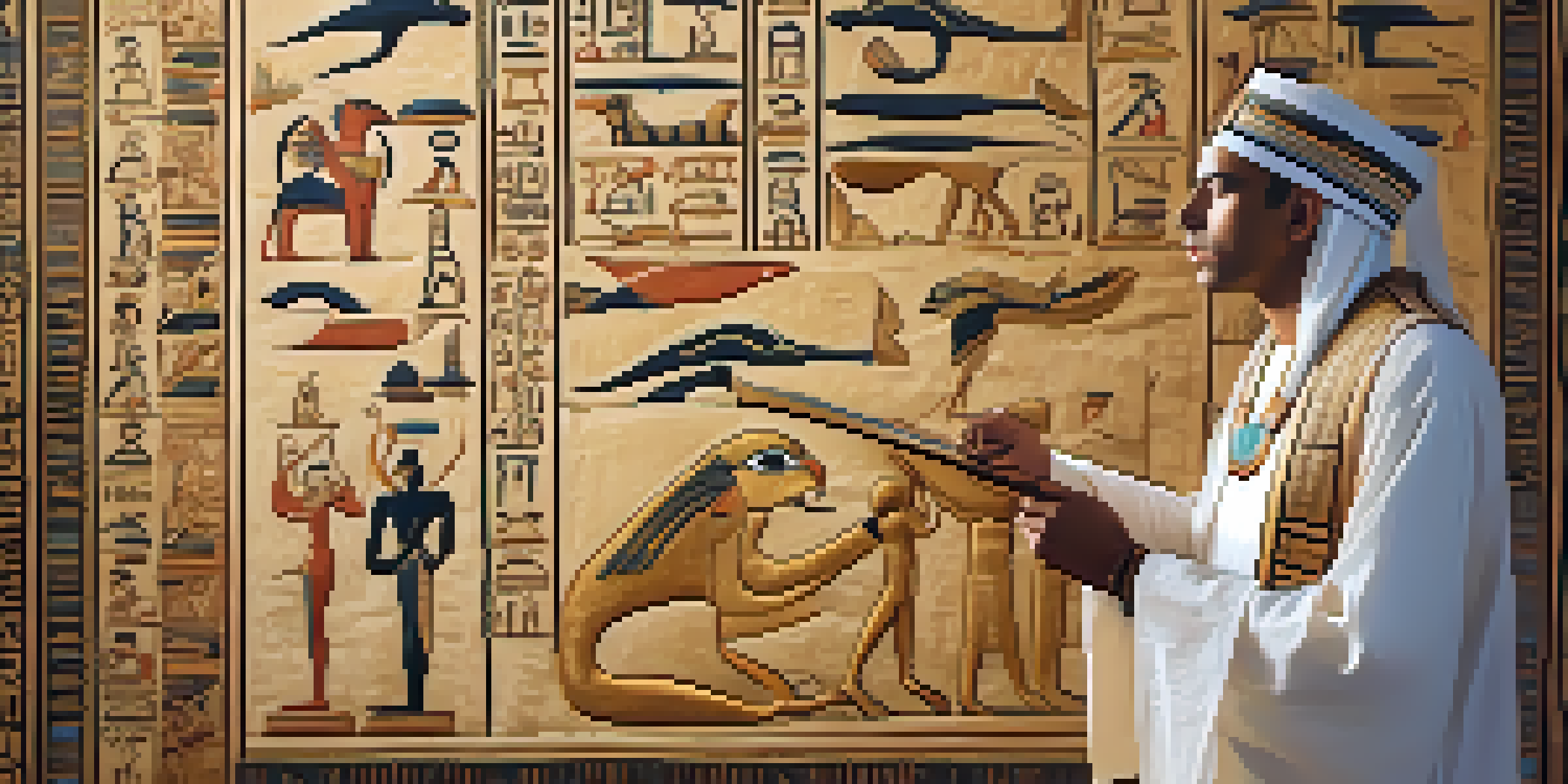The Influence of Ancient Civilizations on Dream Interpretation

The Role of Dreams in Ancient Societies
Throughout history, dreams have held significant meaning in various cultures. Ancient societies viewed dreams as messages from the divine or the subconscious, often guiding important decisions. For instance, in ancient Egypt, dreams were believed to be prophetic, with priests interpreting them to provide insights to pharaohs.
Dreams are the touchstones of our character.
The Greeks also revered dreams, considering them a bridge between the mortal and the divine. Scholars like Aristotle and Hippocrates investigated the nature of dreams, proposing that they were reflections of the dreamer's physical and emotional state. This exploration marked the beginning of a more systematic approach to understanding dreams.
Overall, the role of dreams in these ancient societies set the foundation for how we perceive dreams today. By treating dreams as significant, these cultures established a tradition that emphasizes the importance of dream interpretation.
Egyptian Dream Interpretation Techniques
In ancient Egypt, dream interpretation was a highly regarded practice with its own set of techniques. Egyptians believed that dreams could offer insights into the future, health, and even personal relationships. They often sought the guidance of priests, who were trained in the art of interpretation and could decipher the symbols within dreams.

One common practice involved keeping a dream journal, where individuals recorded their dreams upon waking. This technique not only helped in recalling dreams but also allowed for deeper analysis over time. By reviewing these records, dreamers could identify patterns and recurring themes that might hold personal significance.
Ancient Cultures Valued Dreams
Various ancient societies viewed dreams as significant messages from the divine, influencing important decisions and personal insights.
Egyptians also relied on symbolic interpretation, where certain images or events in a dream were linked to specific meanings. For instance, dreaming of the Nile could symbolize abundance, while a dream of a snake might indicate danger. These methods showcased a sophisticated understanding of dreams that laid the groundwork for future interpretations.
The Greek Philosophical Approach to Dreams
Greek philosophers contributed significantly to the understanding of dreams, blending mythology with early psychology. Figures like Plato and Aristotle examined dreams not only as mystical experiences but also as reflections of reality and the psyche. Plato suggested that dreams could reveal the truth about one’s character and desires.
Dreams can be the key to understanding the mind's hidden desires.
Aristotle took a more scientific approach, proposing that dreams were linked to sensations experienced during waking life. He believed that dreams could serve as a window into our emotions and physical state, an idea that resonates with modern interpretations of dreams. This philosophical groundwork helped shift the perception of dreams from purely mystical to a more analytical perspective.
The Greek emphasis on rational thought laid the foundation for future dream analysis, influencing later scholars and psychologists. Their discussions on dreams encouraged a more structured approach, fostering a deeper exploration of human consciousness and the significance of dreams.
Chinese Perspectives on Dream Interpretation
In ancient China, dreams were also seen as vital, often linked to the concept of qi, or life energy. Dreams were believed to reflect the balance or imbalance of qi within a person, making them a crucial aspect of health and well-being. Chinese scholars studied dreams as part of their broader understanding of medicine and spirituality.
Dreams were interpreted through the lens of Confucianism and Taoism, emphasizing harmony and natural balance. For instance, dreaming of a dragon could symbolize power and potential, while a dream of a river might indicate a need for change. These symbolic interpretations helped individuals understand their feelings and circumstances.
Techniques for Dream Interpretation
Practices like keeping dream journals and symbolic analysis were common in ancient cultures, laying the groundwork for modern dream interpretation.
The focus on holistic understanding in Chinese dream interpretation highlights the interconnectedness of mind, body, and spirit. This perspective has continued to influence contemporary practices, emphasizing that our dreams can provide guidance in our daily lives.
Mesopotamian Views on Dreams and Omens
In Mesopotamian culture, dreams were closely tied to omens and prophecy, often regarded as messages from the gods. The Babylonians and Assyrians developed extensive dream dictionaries that assigned specific meanings to various dream symbols. These interpretations were crucial for decision-making in both personal and political contexts.
For example, a dream about a lion might warn of impending danger, while a dream involving water could signify prosperity. This structured approach to dream interpretation demonstrated a sophisticated understanding of the relationship between dreams and reality, influencing future civilizations.
The emphasis on omens in Mesopotamian dream interpretation reflects a broader belief in the interconnectedness of human experiences and the divine. This belief system laid the groundwork for later interpretations in various cultures, reinforcing the idea that dreams could guide human actions.
The Legacy of Ancient Dream Interpretation
The practices and beliefs surrounding dream interpretation from ancient civilizations have left a lasting legacy. Modern psychology and dream analysis owe much to the foundations established by these early cultures. Concepts such as symbolism, the significance of recurring dreams, and the importance of emotional context can all be traced back to ancient interpretations.
Moreover, the belief that dreams can provide insights into our unconscious mind continues to resonate today. Therapists and counselors often encourage clients to explore their dreams as a means of understanding their emotions and experiences. This enduring relevance showcases how ancient wisdom can still inform our understanding of the human psyche.
Legacy of Ancient Insights Today
The foundational beliefs surrounding dreams from ancient civilizations continue to inform contemporary psychology and self-discovery practices.
Ultimately, the influence of ancient civilizations on dream interpretation highlights the universal quest for meaning and understanding in our lives. As we continue to explore our dreams, we honor the rich history that shaped our perceptions and practices.
Modern Interpretations: Bridging Ancient Wisdom and Today
In today's world, dream interpretation has evolved, yet the core ideas from ancient civilizations remain relevant. Many modern psychologists draw upon the symbolic interpretations and cultural contexts established by ancient cultures. By integrating these principles, contemporary dream analysis becomes a rich tapestry of historical and psychological insights.
For example, Carl Jung's theories of archetypes and the collective unconscious echo ancient beliefs in the shared significance of dream symbols. This connection underscores the timeless nature of dreams and their ability to reflect universal human experiences. Modern dream therapy often encourages individuals to explore personal interpretations while acknowledging cultural influences.

As we navigate our dreams in the modern age, we carry forward the wisdom of ancient civilizations. Their insights remind us that dreams are not just fleeting images but powerful tools for self-discovery and understanding.